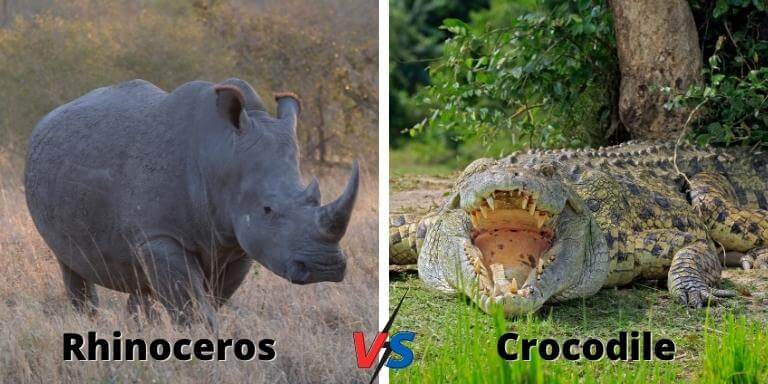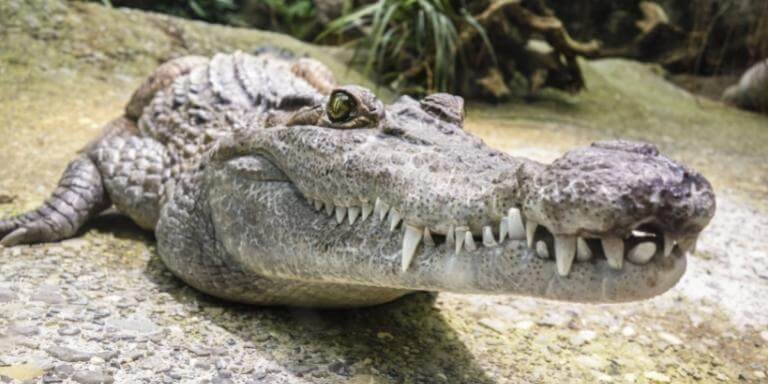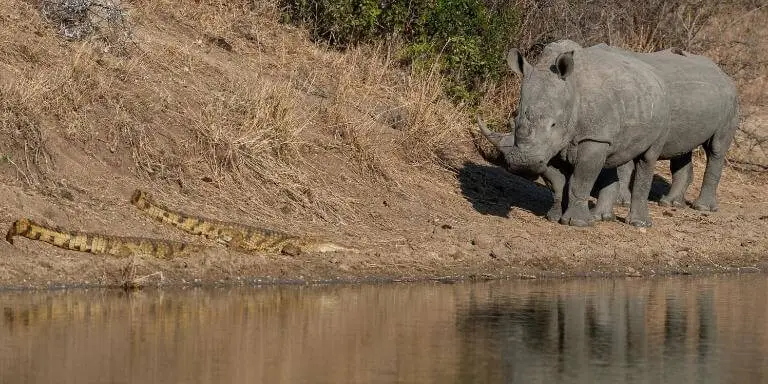Rhinoceros are the second-largest land mammal just after the African elephants. The massive horn on their nose doesn’t go without notice. An angry rhinoceros is undoubtedly a great threat if you’re in the wild.
Whereas, the Crocodile is also the largest extant reptile on the planet. Their huge snout or muzzle can vary at large proportions. All their species are known for biting and drowning the prey to death.
But what would be the result of these two clashing face to face? We’d say, rhinoceros would definitely have the upper hand.

Rhinoceros vs Crocodile – Comparison Chart
| Comparison With | Rhinos | Crocodiles |
|---|---|---|
| Scientific classification | Rhinocerotidae | Crocodylidae |
| Size | The average height is about 5 to 7 feet. The body length of an adult is about 10 to 13 feet. | An average adult can grow up to 17 feet long. But some specimens of 23 feet are also found. |
| Weight | Average adults are about 900 kg (1900 pounds) to 2300 kg (5000 pounds) heavy. | The average grown-up weighs about 1000 pounds. But specimens of 2200 pounds (1000kg) are not uncommon. |
| Diet | Herbivorous creature. | Carnivorous creature |
| Speed | Can run up to 55 km/h. | Can swim up to 35 km/h. |
| Behavior | About 35 years in the wild and 40 years in captivity. | 50 to 75 years in the wild. In captivity, the lifespan is similar to that in the wild. |
| Lifespan | Typically peaceful but can lose their temper if threatened. | Very aggressive and will attack without a second thought. |
| Habitat | Semi deserts, savannahs, forests, and wetlands. | They prefer tropical habitats near lakes, rivers, wetlands, and saltwater regions. |
| Population | About 27000 worldwide. | Thousands of crocodiles still exist worldwide. |
| Predator | Lions, tigers, crocodiles, and humans. | Humans, large felines, and birds of prey. |
Crocodile vs Rhino – Fight in the Wild

Rhinos are peaceful beings and tend to live alone. But a female rhino can easily lose her temper if her calf is under attack. However, this is exactly what the crocodile does to the rhino. It chases after the calf while both are in the water. This enrages the rhino to its limit. Then fierce life and death battles occur. But who wins the final fight?
The result of the fight can be easily determined. If the battle takes place on land, the reptile doesn’t have much of a chance. The massive rhinoceros can easily stomp the croc to death.
Moreover, the huge pointy horn is the principal offensive weapon of a rhinoceros. It can easily toss the crocodile away with the horn. The reptile then wouldn’t have much of an option rather than just fleeing the picture. The worst-case scenario can occur if the herbivore impales the croc with the spike. So the result is obvious when the battle is on land.

But inside water holes, the Crocodile has a chance. It can swim faster in water. Their average speed (about 15-20 miles/hour) is twice the speed of the gold-winning Olympic swimmers. It can even breathe underwater. Moreover, it lives inside water. So it already has the upper hand.
If a rhino is fully submerged or even half-submerged in croc-infested water, its life can be in danger. While crossing lakes and shallow rivers in the wild, their calves are taken underwater by the crocs. The croc first bites on its prey with immense force. Croc has at least 60 sharp teeth inside its mouth.
The bite force of crocodiles is the strongest on the planet. They have a jaw about 8 times stronger than a lion and four times stronger than a grizzly bear. After that when it is certain that it has grabbed on the limb for good, it immediately starts rotating at a great speed. This action injures the prey very badly. It often tears off skin and flesh and even nastily breaks the bone by twisting it. They like to drag the prey inside water and drown them to death.
These elite hunters are seen biting the face off of a Zebra and then eating it up alive. The Nile crocodile of the African continent has the strongest bite force ever. It was measured as about 3700 psi.
Defense Mechanisms

The rhinoceros roll-on dust and sink in mud for protection against predators and insects. Their thick skin provides protection against attackers also. However, they are very agile on their feet. So if they are in a difficult situation, they can easily flee the place avoiding the threat. Their acute hearing and smelling abilities also protect them from abrupt danger.
Crocs use their tails for defense. They can slash the opponent’s skin off with it. Besides they have acute hearing abilities which helps them to evade danger.
Conclusion
Rhino vs crocodile fight result is obvious. The herbivore can easily defeat the reptile on land. The only option for the Nile Croc of Africa is to flee on its belly while on land. But it can oppose a threat to the giant rhinoceros inside water holes. Often crocs attack the injured prey or the unattended rhino calf. In this situation, the rhino has a narrow chance of survival.
You might also be interested in:
- Rhino vs Hippo | Who Would Win in a Fight?
- Elephant vs Hippo | Who Would Win in a Fight?
- Differences Between Northern and Southern White Rhino
- Hippo vs Crocodile | Who Would Win in a Fight?
- Rhino vs Lion | Who Would Win in a Fight
- Rhino vs Elephant | Fierce Combat in The Wild
- Rhino vs Tiger Who Would Win in a Fight?

Thanks you.
https://hop.cx